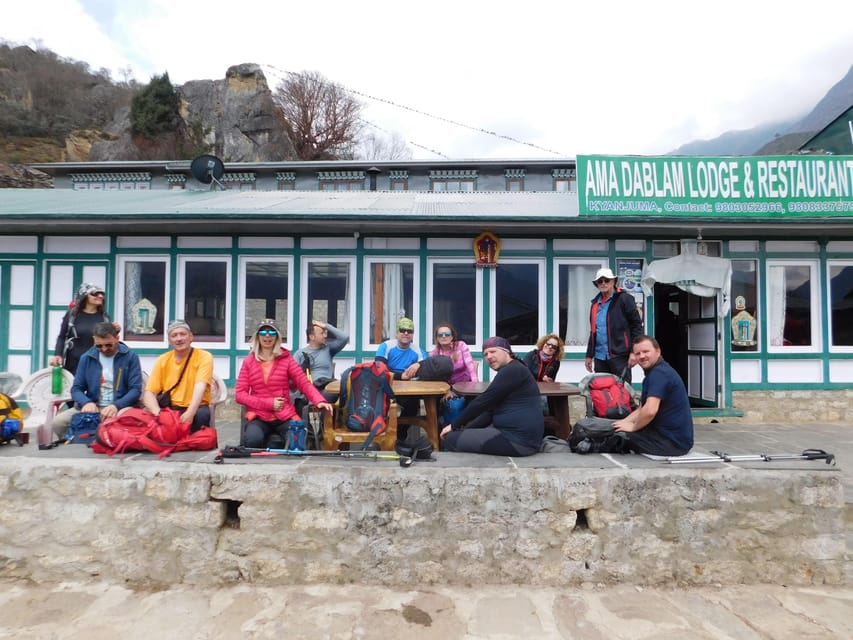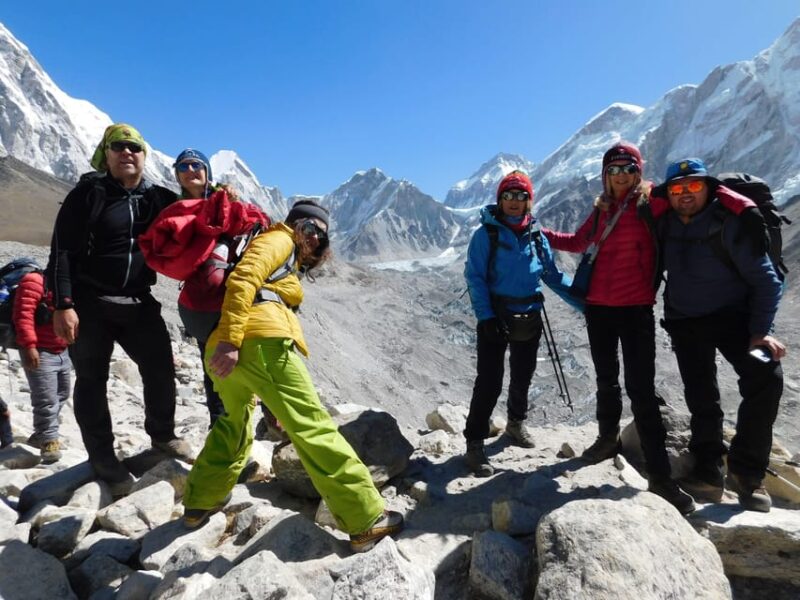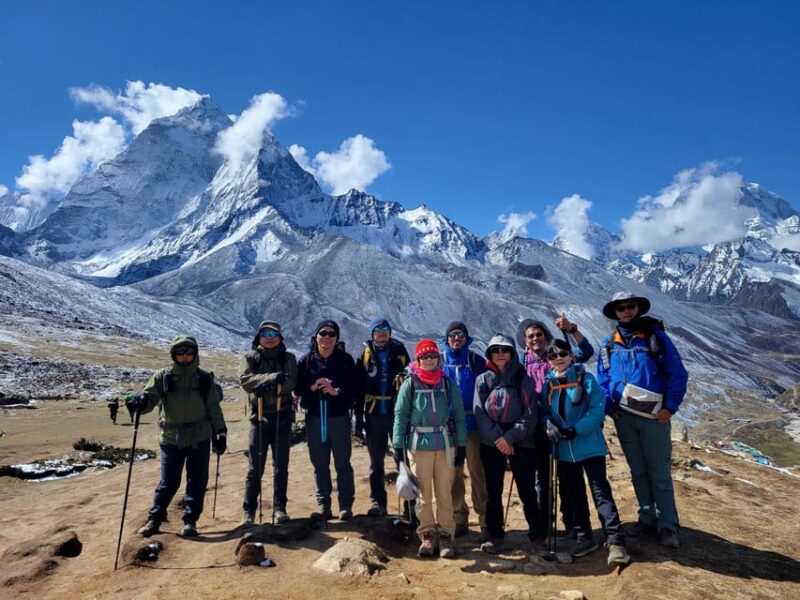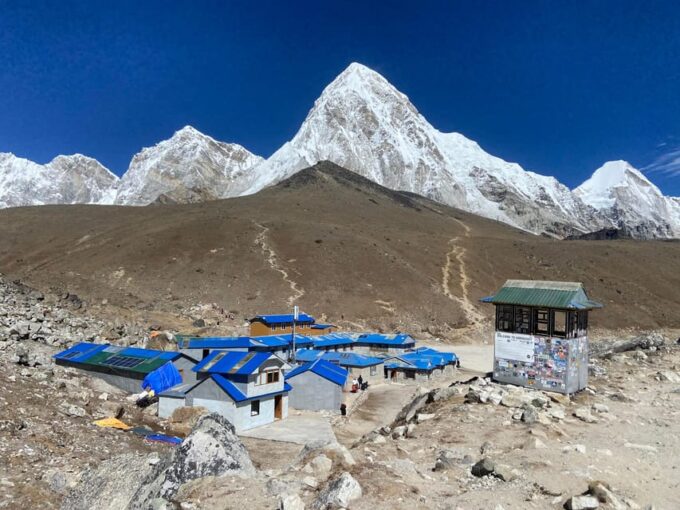The 14-day Everest Base Camp Trek stands as a remarkable journey through the Himalayas, attracting adventurers keen on experiencing both the breathtaking landscapes and rich Sherpa culture. Starting in vibrant Kathmandu, trekkers will find themselves traversing picturesque villages, with planned acclimatization days ensuring they safely adjust to the altitude. Along the way, they’ll visit iconic sites like Tengboche Monastery and enjoy stunning vistas from Kalapathar. Yet, before setting off, there are important considerations to keep in mind that can significantly impact the experience. What exactly should trekkers know to prepare for this adventure?
Key Points

- The 14-day Everest Base Camp trek includes a gradual ascent through picturesque Sherpa villages, ensuring proper acclimatization to high altitudes.
- Participants will experience stunning views, including visits to Tengboche Monastery and Kalapathar, the latter offering breathtaking panoramas of Everest.
- The trek involves essential preparation, including obtaining permits, and includes round-trip flights to Lukla and accommodations in teahouses.
- Safety measures are crucial, emphasizing hydration, rest days for acclimatization, and packing a first aid kit for emergencies.
- Cultural engagement with the Sherpa community enriches the trek, showcasing their traditions, cuisine, and hospitality along the journey.
Trek Overview and Itinerary

Embarking on the Everest Base Camp Trek offers an incredible 14-day adventure that combines breathtaking landscapes and rich Sherpa culture, all while challenging trekkers to reach the iconic Base Camp at 5,463 meters.
The journey kicks off in Kathmandu, where trekkers prepare for the trek ahead. They’ll fly to Lukla and then trek through picturesque villages, including Namche Bazaar, gaining altitude gradually. Acclimatization days ensure everyone adjusts to the thin air.
Highlights include visiting the historic Tengboche Monastery and stunning views from Kalapathar at 5,545 meters. Each day presents new challenges and rewards, making the trek an unforgettable experience.
You can also read our reviews of more tours and experiences in Pheriche.
Inclusions and Services

The Everest Base Camp Trek includes a comprehensive range of services designed to ensure a smooth and enjoyable experience for participants.
Travelers can expect private vehicle transfers to and from the airport and hotel, along with two nights in a comfortable 3-star hotel in Kathmandu, breakfast included.
Essential trekking permits and entrance fees are covered, as well as round-trip domestic flights to Lukla.
During the trek, you will stay in teahouses, guided by experienced trekking professionals.
The package also offers a first aid medical kit, a farewell dinner with a cultural program, and an adventure certificate upon completion.
For emergencies, helicopter rescue services are available, but travelers must have travel insurance.
Porters can be hired at an additional cost.
Participant Requirements

Before joining the Everest Base Camp Trek, participants should be aware of specific requirements and restrictions to ensure a safe and enjoyable adventure.
This trek isn’t suitable for children under 10, pregnant women, or anyone with heart, respiratory, or kidney issues. Wheelchair users and visually impaired individuals also won’t be able to participate.
Plus, those over 80 years old or weighing more than 331 lbs (150 kg) must reconsider. Recent surgery patients and individuals over 70 should consult their doctor before signing up.
It’s essential for trekkers to assess their physical condition honestly, as the demanding altitude and terrain can pose challenges, making proper preparation crucial for a rewarding experience in the Himalayas.
Essential Packing List

Packing for the Everest Base Camp Trek requires careful consideration to ensure trekkers have everything they need for a comfortable and safe journey in the Himalayas.
First and foremost, a valid passport and visa (if required) are essential.
Layering is key, so warm clothing, thermal layers, and a durable jacket are vital. Sturdy hiking shoes will keep feet protected, while gloves and a head covering shield against the cold.
Trekkers shouldn’t forget sunglasses and sunscreen to protect against high-altitude sun exposure. A towel, a change of clothes, and a camera are also handy for personal comfort and memories.
More Great Tours NearbyDaily Trek Breakdown

Each day of the Everest Base Camp Trek offers unique challenges and breathtaking views, making careful planning essential for a rewarding experience.
On Day 1, trekkers arrive in Kathmandu, followed by a flight to Lukla and a trek to Phakding on Day 2.
The trek to Namche Bazar on Day 3 showcases the Sherpa culture.
Days 4 and 7 are reserved for acclimatization, crucial for adjusting to the altitude.
The journey continues to Tengboche and Dingboche, with stunning vistas along the way.
Days 9 and 10 include visits to Everest Base Camp and Kalapathar, rewarding trekkers with incredible panoramas.
Acclimatization Importance

Acclimatization is crucial for trekkers aiming to conquer Everest Base Camp, as it helps the body adjust to the high altitudes and reduces the risk of altitude sickness.
During the trek, trekkers spend specific days at higher elevations, allowing their bodies to adapt gradually. This process involves increasing red blood cell production, improving oxygen delivery, and enhancing overall endurance.
Without proper acclimatization, trekkers may experience symptoms like headaches, nausea, or fatigue, which can derail their journey. It’s essential to listen to one’s body and take necessary rest days, especially after reaching significant altitudes.
Cultural Insights

Exploring the rich Sherpa culture along the Everest Base Camp trek offers trekkers a unique glimpse into the traditions, beliefs, and daily lives of the local communities.
Trekkers can witness the vibrant festivals celebrated in villages, often filled with music, dance, and colorful attire.
Visiting monasteries allows an understanding of the deep-rooted Buddhist practices that shape daily life.
Local cuisine, featuring dishes like dal bhat and momos, reflects the region’s agricultural heritage.
Engaging with Sherpa families provides insights into their hospitality and communal living.
Plus, trekkers might learn about the significance of the Khumbu region’s natural landscape, which holds spiritual importance for the Sherpas.
These cultural encounters enrich the trekking experience, making it truly unforgettable.
Safety Considerations

While immersing in the rich Sherpa culture, trekkers should also be aware of important safety considerations to ensure a smooth and enjoyable journey along the Everest Base Camp trek.
Acclimatization is crucial; trekkers must take rest days to adapt to the high altitude and avoid altitude sickness. Staying hydrated and eating well helps maintain energy levels.
It’s wise to pack a first aid kit and familiarize oneself with its contents. Trekkers should always trek with a guide and not venture off the marked trails.
Weather conditions can change rapidly, so checking forecasts daily is essential.
Lastly, having comprehensive travel insurance that covers emergencies, including helicopter rescues, is a must for any adventurer tackling this stunning trek.
Frequently Asked Questions

How Physically Fit Do I Need to Be for the Trek?
For this trek, one doesn’t need to be an athlete, but decent fitness helps. Regular walking, some hill training, and stamina-building activities will make the journey more enjoyable and manageable, ensuring a smoother experience overall.
What Is the Best Time of Year to Trek?
When planning a trek, the best times are typically spring (March to May) and autumn (September to November). These months offer stable weather, clearer skies, and pleasant temperatures, perfect for enjoying breathtaking views and comfortable hiking experiences.
Can I Charge My Devices During the Trek?
During the trek, charging devices can be tricky. Most teahouses offer charging facilities for a fee, but it’s best to bring a power bank to ensure devices stay charged throughout the journey.
Are There Any Communication Facilities Along the Route?
Along the route, he found limited communication facilities. Most teahouses offered Wi-Fi, but connectivity varied. Cell service existed in some areas, yet he should prepare for potential outages during the trek.
What Should I Do in Case of Altitude Sickness?
When altitude sickness strikes, they should descend to a lower elevation, stay hydrated, and rest. Seeking medical attention is crucial if symptoms worsen. It’s important not to ignore warning signs and prioritize health above all.
Recap
To sum it up, the 14-day Everest Base Camp Trek is a remarkable journey that blends adventure with culture.
With stunning landscapes, rich Sherpa heritage, and the thrill of reaching base camp, it’s an experience like no other.
Proper preparation, including packing wisely and understanding acclimatization, ensures a safe and enjoyable trek.
Whether you’re a seasoned hiker or a first-timer, this trek promises unforgettable memories and breathtaking views that will stay with you long after you’ve returned home.
You can check availability for your dates here:More Hiking & Trekking Tours in Pheriche
More Tour Reviews in Pheriche
Not for you? Here's more nearby things to do in Pheriche we have reviewed
- Everest Base Camp Trek
- Kathmandu: 20 Day Everest Base Camp Trek with Kalapatthar
- Kathmandu : 14 -Day Everest Base Camp with Kala Patthar Trek
- Everest base camp trek 12 days
- Lukla: 11-Day Everest Base Camp Trek from Lukla with Guide
- Nepal: Everest Base Camp with Kalapathar Trek
- From Kathmandu: 12 – Day Everest Base Camp Guided Trek
- Kathmandu: Everest Helicopter Tour with Syangboche Landing
- From Kathmandu: 11- Day Everest Base Camp Trek with Guide
- From Pokhara: 11-Day Budget Everest Base Camp Trek
- Kathmandu : Budget 15-Day Everest Base Camp Trek /2025
- From Lukla: 18-Day Everest Base Camp and Gokyo Lakes Trek
